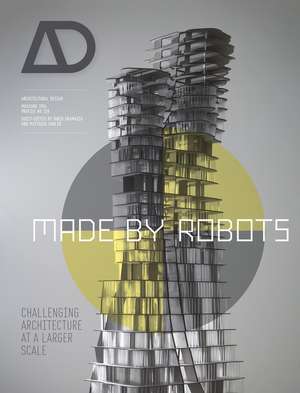Made by Robots – Challenging Architecture at a Larger Scale AD
Autor M Gramazioen Limba Engleză Paperback – 24 apr 2014
Preț: 165.78 lei
Preț vechi: 229.73 lei
-28% Nou
31.72€ • 33.19$ • 26.35£
Carte indisponibilă temporar
Specificații
ISBN-10: 1118535480
Pagini: 136
Dimensiuni: 211 x 273 x 10 mm
Greutate: 0.52 kg
Editura: Wiley
Locul publicării:Chichester, United Kingdom
Public țintă
Primary market: Architects and architectural studentsSecondary market: Structural, building and civic engineers
Descriere
Although highly ambitious and sophisticated, most attempts at using robotic processes in architecture remain the exception; little more than prototypes or even failures at a larger scale. This is because the general approach is either to automate existing manual processes or the complete construction process. However, the real potential of robots remains unexploited if used merely for the execution of highly repetitive mass-fabrication processes: their capability for serial production of non-standard elements as well as for varied construction processes is mostly wasted. In order to scale up and advance the application of robotics, for both prefabrication and on-site construction, there needs to be an understanding of the different capabilities, and these should be considered right from the start of the design and planning process. This issue of AD showcases the findings of the Architecture and Digital Fabrication research module at the ETH Zurich Future Cities Laboratory in Singapore, directed by Fabio Gramazio and Matthias Kohler, which explores the possibilities of robotic construction processes for architecture and their large-scale application to the design and construction of high-rise buildings. Together with other contributors, they also look at the far-reaching transformations starting to occur within automated fabrication: in terms of liberation of labour, entrepreneurship, the changing shape of building sites, in-situ fabrication and, most significantly, design.
Contributors: Thomas Bock, Jelle Feringa, Philippe Morel, Neri Oxman, Antoine Picon and François Roche.
ETH Zurich contributors: Michael Budig, Norman Hack, Willi Lauer and Jason Lim and Raffael Petrovic (Future Cities Laboratory), Volker Helm, Silke Langenberg and Jan Willmann.
Featured entrepreneurs: Greyshed, Machineous, Odico Formwork Robotics, RoboFold and ROB Technologies.
